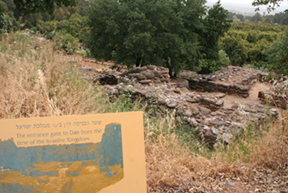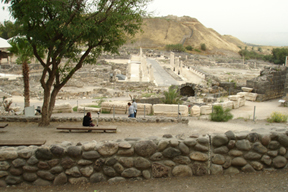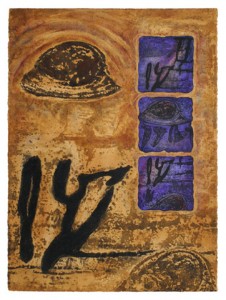I visited Israel recently and saw layer upon layer of many different civilizations and religions that inhabited the land. While there I explored Tell Dan in northern Israel and also climbed the tell at Beit She’an to view the excavations below. Archaeology has always been interesting to me.
A perfect accompaniment on the trip was The Source by James Michener. It’s a fictitious historical novel about Tell Makor in northern Israel, where archaeologists dig through multiple layers of the tell or mound and uncover 10,000 years of civilization. Each layer in the tell unearths artifacts from a previous period in time, and the story then reverts back to that time.
What is particularly interesting in The Source is the evolution of religion and “god”. It starts with Stone Age man and the first glimpses of spirituality; then proceeds with the fertility goddess Astarte and the fertility god/s Baal, describing in detail the various sacrifices and monoliths. The Cananite deity El eventually evolved into El Shaddai, and then into Yahweh (YHWH), the Hebrew god of Moses and possibly his ancestors. Monotheism (one god) starkly contrasted with the polytheistic (multiple gods) of the Greeks and Romans in later years.
One of my Arborglyph monoprints is called All Seeing Yahweh. For many Jewish people, the name Yahweh should never be spoken. Therefore, the Tetragrammaton or four letters YHWH often replaces the name Yahweh. However it’s possible that:
Hebrew scripts write it as four consonants, rendered in Roman letters as YHWH, due to the fact that most alphabets, prior the Greek alphabet, did not display vowels, and required that vowels be mentally pronounced in the proper places.
And although the name Yahweh should not be spoken, the Jewish Encyclopedia states that The Old Testament had 6,823 references to Yahweh.
Yahweh was a strong, demanding ‘god’ to the Hebrews. The meaning of the word Yahweh has been interpreted as “to be”, or according to WordIQ many scholars believe it means “He Brings into Existence Whatever Exists”. This coincides with a timelessness about ‘gods’ existence. Which gets back to the novel The Source and its prevailing theme of many gods and religions throughout the centuries in Israel.
My Arborglyph monoprint, All Seeing Yahweh has several images with an IY symbol and also contains several ‘tree eyes’; hence the All Seeing title. The “all-seeing eye” has been associated with several other religions or cultures… The “Eye of Horus” in Egypt, the “Eye of the World” in Buddhism and the Christian Trinity.
The “all-seeing eye of God” is also analagous to the “Eye of Providence” which generally depicts an eye that is sometimes surrounded by a triangle. This “Eye of Providence” is on the Great Seal of the United States and is also a Free Masonry symbol. The eye icon is a powerful image in many cultures and in countless artworks.



Leave a Reply